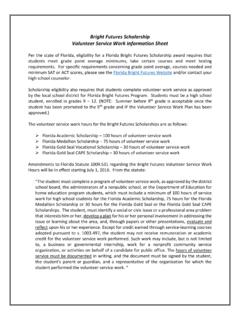Transcription of Children and Grief Statistics - Children's Grief Awareness Day
1 Did You Know? Children and Grief Statistics 1 in 5 Children will experience the death of someone close to them by age 18. (Kenneth Doka, Editor of OMEGA, Journal of Death and Dying). In a poll of 1,000 high school juniors and seniors, 90% indicated that they had expe- rienced the death of a loved one. ( ). One in every 1,500 secondary school students dies each year. ( ). One out of every 20 Children aged fifteen and younger will suffer the loss of one or both parents. These Statistics don't account for the number of Children who lose a parental figure, such as a grandparent or other relative that provides care. (Owens, D. Recognizing the Needs of Bereaved Children in Palliative Care Journal of hospice & Palliative Nursing. 2008; 10:1). million Children are living in a single-parent household because of the death of one parent. (Owens, D. Recognizing the Needs of Bereaved Children in Palliative Care Journal of hospice & Palliative Nursing. 2008; 10:1). Mortality rates for adults in their 40s and 50s in the past two decades have risen dramatically, making it more likely that younger Children will experience the death of a parent, or a classmate's parent.
2 Kids are encountering death more often and at a younger age it's just inevitable, says Gerald Koocher, chief of psychology at Boston's Children 's Hospital. ( Early Grief Wall Street Journal, Feb. 18,1999). It is estimated that 73,000 Children die every year in the United States. Of those Children , 83 percent have surviving siblings. (Torbic, H. Children and Grief : But what about the Children ? Home Healthcare Nurse. 2011;29(2):67-79). #CGADHope . Did You Know? Children and Grief Statistics In a study of 11- to 16-year-olds, 78% reported that at least one of their close relatives or friends had died. (Harrison and Harrington, 2001). Reviews of studies from various countries on childhood bereavement following parental death report that Children in this situation do experience a wide range of emotional and behavioral symptoms . The child often experiences an increase in anxiety with a focus on concerns about further loss, the safety of other family members, and fears around separation.
3 (Dowdney, 2000; Haine et al., 2008). Key Results of Childhood Bereavement Study completed by Comfort Zone Camp (2009). 56% of respondents who lost a parent growing up would trade a year of their life for one more day with their departed parent. 72% believe their life would have been much better if their parent hadn't died so young. 69% of Americans who lost a parent growing up still think about their parent frequently. Grieving in Schools: Nationwide Survey among Classroom Teachers on Childhood Bereavement Conducted by New York Life Foundation and American Federation of Teachers, 2012. Classroom teachers report that students who have lost a parent or guardian typically exhibit: - Difficulty concentrating in class (observed by 87% of teachers). - Withdrawal/disengagement and less class participation (observed by 82%). - Absenteeism (observed by 72%). - Decrease in quality of work (observed by 68%). - Less reliability in turning in assignments (observed by 66%). 7 in 10 teachers (69%) currently have at least one student in their class(es) who has lost a parent, guardian, sibling, or close friend in the past year.
4 #CGADHo
